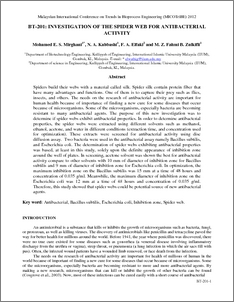Mirghani, Mohamed Elwathig Saeed and Kabbashi, Nassereldeen Ahmed and Elfaki, Faiz Ahmed Mohamed and , M. Z. Fahmi
(2012)
BT-201: Investigation of the spider web for antibacterial activity.
In: 2nd Malaysian International Conference on Trends In Bioprocess Engineering (MICOTriBE 2012), 3–5 July 2012., Meritus Pelangi Beach Resort & Spa Langkawi, Kedah, Malaysia.
![[img]](http://irep.iium.edu.my/style/images/fileicons/application_pdf.png)  Preview |
|
PDF (BT-201: Investigation of the spider web for antibacterial activity)
- Published Version
Download (126kB)
| Preview
|
Abstract
Spiders build their webs with a material called silk. Spider silk contain protein fiber that have many advantages and functions. One of them is to capture their prey such as flies, insects, and others. The needs on the research of antibacterial activity are important for human health because of importance of finding a new cure for some diseases that occur because of microorganisms. Some of the microorganisms, especially bacteria are becoming resistant to many antibacterial agents. The purpose of this new investigation was to determine if spider webs exhibit antibacterial properties. In order to determine antibacterial properties, the spider webs were extracted using different solvents such as methanol, ethanol, acetone, and water in different conditions (extraction time, and concentration used for optimization). These extracts were screened for antibacterial activity using disc
diffusion assay. Two bacteria were used in the antibacterial assay namely Bacillus subtilis, and Escherichia coli. The determination of spider webs exhibiting antibacterial properties was based, at least in this study, solely upon the definite appearance of inhibition zone around the well of plates. In screening, acetone solvent was shown the best for antibacterial
activity compare to other solvents with 10 mm of diameter of inhibition zone for Bacillus subtilis and 9 mm of diameter of inhibition zone for Escherichia coli. In optimization, the maximum inhibition zone on the Bacillus subtilis was 15 mm at a time of 48 hours and concentration of 0.035 g/ml. Meanwhile, the maximum diameter of inhibition zone on the Escherichia coli was 12 mm at a time of 48 hours and concentration of 0.035 g/ml. Therefore, this study showed that spider webs could be potential source of new antibacterial agents.
Actions (login required)
 |
View Item |


 Download Statistics
Download Statistics Download Statistics
Download Statistics